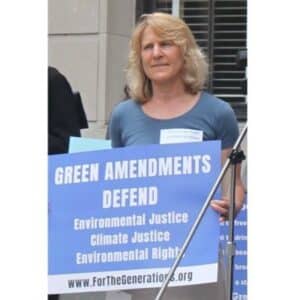In June, I traveled to Montana to watch the trial Held v. Montana, in which 16 young people are challenging the failure of their state government to address the climate crisis. The 16 youth plaintiffs testified to the despair, fear, health harms, recreational decline, and quality of life impacts inflicted upon them by the heat, wildfires, pollution, and degraded environment the climate crisis is imposing on their lives. The state had responded to climate change by passing a law that prohibited state officials from considering the climate changing ramifications of projects they were approving and the actions they were taking – including government approval of, and support for, the ongoing extraction, transportation and consumption of fossil fuels.
Represented by attorneys from Our Children’s Trust and the Western Environmental Law Center and joined by a cadre of nationally and internationally recognized experts on climate, environment, economics, human health, energy, and law, the youth plaintiffs are making the case that their government is failing to fulfill their duty to protect the rights of all Montanans to a safe climate.
Why is this case different from other climate legal actions?
Because Montana is one of only three states nationwide that has a constitutional Green Amendment. As a result, the people in Montana have a constitutional right to a clean, and healthful environment. The failure to address the climate crisis – by both exacerbating it and refusing to even consider how government action was making the crisis worse – is a failure to fulfill the rights of the youth and the constitutional duty of Montana state government.
Notably, the other two states with Green Amendments are Pennsylvania and New York. In Pennsylvania, my Delaware Riverkeeper Network defeated a devastatingly pro-fracking law in 2013 because of the constitutional right of all Pennsylvanians to pure water, clean air, and a healthy environment, and the duty of government officials to protect the state’s natural resources for present and future generations. In New York, the Green Amendment movement was successful in securing a constitutional right to clean water and air, and a healthful environment in 2022; it is now being used in meaningful ways, including to address greenhouse gas emissions from a massive and expanding landfill.
The attorneys for the state of Montana framed the case as just another “boring” question of law—their word, not mine. But the young plaintiffs shared a far graver and concerning picture of what is at stake. Throughout the trial, the plaintiffs provided testimony of the ravages of the climate crisis. They exposed how a Montana legislative prohibition on considering the climate impacts of fossil fuel extraction, transport, processing, and use in the state is harming their physical, psychological, cultural and economic stability.

– Youth plaintiff Sariel is a member of the Confederated Salish and Kootenai tribe. Sariel shared how the climate crisis was changing when and where traditional foods and medicines would grow, making it harder to find and collect them. She also shared how these dramatic changes in the natural world were impacting Native American oral tradition and rendering the stories handed down from generation to generation inaccurate leading to an undermining of knowledge and ancestral teaching, but also a deep loss of culture and connectivity with her ancestors.

– Youth plaintiff Badge talked about being an avid hunter and fisher, and that his family relied upon the meat he and his family shot and caught. The impacts of climate change – including the declining air quality, floods, drought, and changing health of the environment – threatened this way of life for Badger and his family.

– Youth plaintiff Claire, who as a child was told she may never walk, after years of physical therapy, family support, and strong determination was now a skier and runner. The choking and health-harming smoke from the wildfires take from her the ongoing physical therapy her time in nature, skiing and running continue to provide by driving her and her family indoors.

– The final youth witness was artist Olivia who shared some of her art, including a self-portrait with tears pouring from her eyes. Olivia shared that the painting reflected the despair over climate change she felt. But Olivia was careful to point out that the flowers and the moon (representational of her grandmother) also included in the painting, reflected that she still had hope, hope for a safer climate future.
The plaintiffs case included testimony from experts – among them climate expert Dr. Steve Running; a former employee of the Department of the Interior and expert on the glaciers of Glacier National Park Dr. Dan Fagre; stream ecologist and waterway expert Dr. Jack Stanford; pediatrician Dr. Lori Byron; and Mark Jacobson, Director of Atmosphere & Energy Program at Stanford University who has developed renewable energy analyses for Montana and nationwide – all of whom verified that the climate crisis is already upon us and that it is not just affecting the environment, but also harming the physical health, safety, body and brain development of young people in Montana. Experts, including psychiatrist Dr. Lise van Susteren, confirmed that awareness and experience of climate change creates tremendous psychological stress resulting in depression, increasing suicidal tendencies, more health harms, and even an increased likelihood of early death. The experts made clear that swift action was essential to both prevent climate change from getting worse, and to have the chance of reversing its effects.
Many in government, industry, and the media have tried to characterize this case as pitting youth against adults, liberals versus conservatives, and/or activists versus government. But supporters of the lawsuit, as demonstrated by those who came to view the trial and the plaintiffs themselves, include people from all walks of life and from across the political spectrum. Their ages range from the very young to the elderly, with a wide variety of life and cultural backgrounds. This case is not about ‘us vs them’. This case is about one thing – government’s duty to meaningfully address the climate crisis in order to protect present and future generations. And in Montana, that duty is clearly laid out in the Montana Green Amendment and protecting the right of the people to a clean and healthful environment.
While the state was expected to put on a days-long defense, in the end it rested after just three witnesses with testimony that lasted less than a day. The two state agency witnesses asserted that, when it came to climate, they were powerless to comply with the constitutional obligation to protect the environmental rights of the people of Montana because the state legislature had not explicitly empowered the Montana Department of Environmental Quality and had actually prohibited the consideration of the climate changing ramifications of government action. This was a troubling assertion for many reasons, including legal precedent in all three Green Amendment states (Pennsylvania, New York, and Montana) making clear that compliance with a constitutional obligation to protect environmental rights is not optional for government officials, and that while state law can help guide the interpretation of a constitutional obligation, it cannot displace that obligation.
The final outcome now lies in the hands of Montana State Judge Kathy Seeley. When she will rule we don’t know. But we can be assured that whatever she decides the case will be appealed and ultimately end up in the hands of the Montana Supreme Court. In the meanwhile, this case stands as a demonstration of the value of having a constitutional right to a clean, safe and healthy environment. While having this kind of constitutional entitlement is not an instant panacea for the environmental challenges we face, it does take the strongest legal tool available in U.S. law – our state and federal constitutions – and puts them to work for our environment.
Photos courtesy of https://www.ourchildrenstrust.org/.







